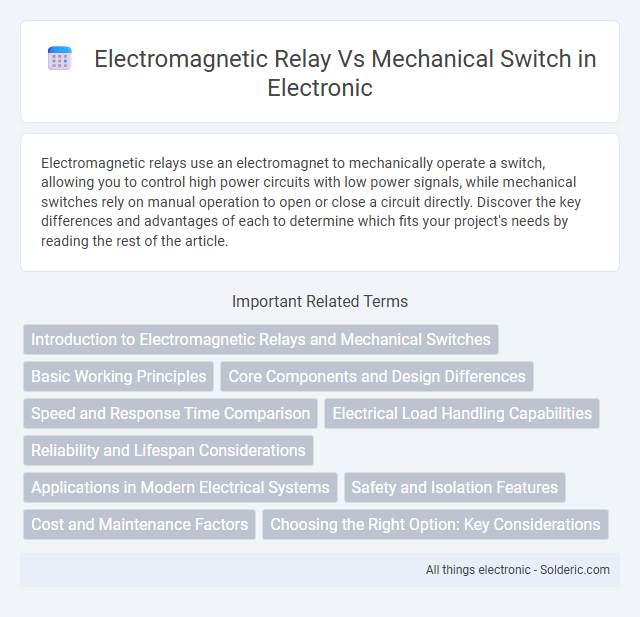Electromagnetic relays use an electromagnet to mechanically operate a switch, allowing you to control high power circuits with low power signals, while mechanical switches rely on manual operation to open or close a circuit directly. Discover the key differences and advantages of each to determine which fits your project's needs by reading the rest of the article.
Comparison Table
| Feature | Electromagnetic Relay | Mechanical Switch |
|---|---|---|
| Operation | Uses electromagnetic coil to open/close contacts | Manually toggled by physical movement |
| Control | Remote, electrically controlled | Direct manual control |
| Switching Speed | Fast switching (milliseconds) | Slower due to manual actuation |
| Contact Wear | Reduced wear; contacts sealed or protected | Higher wear from mechanical friction |
| Life Expectancy | High (millions of cycles) | Lower (thousands to tens of thousands of cycles) |
| Power Consumption | Requires coil power when activated | No power needed for switching |
| Voltage & Current Ratings | Supports high voltage and current loads | Typically lower voltage/current capacity |
| Size & Complexity | Larger, more complex assembly | Compact and simple design |
| Applications | Automated control, switching circuits, protection relays | Manual circuit control, user interface switches |
Introduction to Electromagnetic Relays and Mechanical Switches
Electromagnetic relays use an electric current to generate a magnetic field that actuates a switch, enabling control of high-power circuits with low-power signals. Mechanical switches operate through manual or physical movement to open or close electrical contacts directly, providing straightforward on/off control. Both devices serve critical roles in electrical circuit management, with relays offering remote operation and isolation benefits compared to the direct contact mechanism of mechanical switches.
Basic Working Principles
An electromagnetic relay operates by using an electric current to generate a magnetic field that activates a switch mechanism, enabling remote control of high-power circuits with low-power signals. A mechanical switch functions through direct physical contact, creating or breaking a circuit by manually moving contacts to complete or interrupt the electrical connection. Electromagnetic relays provide electrical isolation and faster switching capabilities compared to traditional mechanical switches, which rely on manual operation and limited endurance.
Core Components and Design Differences
Electromagnetic relays consist primarily of a coil, armature, spring, and set of contacts, enabling electrical control through magnetic fields. Mechanical switches rely on direct physical contact made by moving parts such as toggle or push buttons to open or close circuits. Understanding the core components reveals that electromagnetic relays provide electrically isolated switching with minimal physical wear, unlike mechanical switches that require manual operation and are subject to mechanical degradation.
Speed and Response Time Comparison
Electromagnetic relays generally offer faster response times, typically in the range of milliseconds, compared to mechanical switches that rely solely on manual operation and physical movement. The electromagnetic coil actuates contacts swiftly through magnetic force, reducing latency in circuit activation. Mechanical switches exhibit slower response due to human intervention and mechanical motion, making electromagnetic relays more suitable for applications requiring rapid switching.
Electrical Load Handling Capabilities
Electromagnetic relays can handle higher electrical loads and provide better isolation between control and load circuits compared to mechanical switches. They are designed to switch currents ranging from milliamps up to several hundred amperes, making them suitable for high-power applications. Mechanical switches are limited by contact wear and lower current ratings, typically handling less than 10 amperes in standard designs.
Reliability and Lifespan Considerations
Electromagnetic relays typically offer higher reliability with longer electrical lifespans due to reduced mechanical wear and contact arcing, supporting up to millions of switching cycles. Mechanical switches experience physical degradation over time from contact friction and corrosion, limiting their operational lifespan to tens of thousands of cycles. In critical applications, the choice favors electromagnetic relays for consistent performance and durability under frequent switching conditions.
Applications in Modern Electrical Systems
Electromagnetic relays are widely used in modern electrical systems for remote switching, automation, and protecting circuits due to their ability to handle high voltage and current loads without physical contact. Mechanical switches remain essential for manual control in low-voltage applications and user interfaces where simplicity and reliability are critical. Industries such as automotive, telecommunications, and industrial automation increasingly integrate electromagnetic relays for precise control and durability, while mechanical switches serve as straightforward solutions in consumer electronics and residential wiring.
Safety and Isolation Features
Electromagnetic relays offer superior safety and isolation compared to mechanical switches by using an electromagnetic coil to open or close contacts without direct physical connection, thereby minimizing the risk of electric shock and arcing. Their design ensures electrical isolation between the control circuit and the load, protecting sensitive components and enhancing system reliability. You benefit from enhanced protection in high-voltage applications where mechanical switches may pose safety hazards due to direct contact and wear over time.
Cost and Maintenance Factors
Electromagnetic relays generally have higher initial costs compared to mechanical switches due to their complex internal components and coil requirements. Maintenance expenses for electromagnetic relays may increase over time as coils degrade and contacts wear out from electrical arcing. Mechanical switches often offer lower upfront costs and simpler maintenance but can suffer from faster mechanical wear and require periodic lubrication or replacement.
Choosing the Right Option: Key Considerations
Electromagnetic relays offer superior isolation and control for high-voltage or current applications compared to mechanical switches, which are simpler and more cost-effective for low-power circuits. Key considerations include load capacity, switching speed, durability, and the need for electrical isolation; relays excel in automation and remote switching scenarios, while mechanical switches provide reliable manual operation. Selecting the right option depends on specific application requirements such as power level, switching frequency, and environmental conditions.
electromagnetic relay vs mechanical switch Infographic

 solderic.com
solderic.com